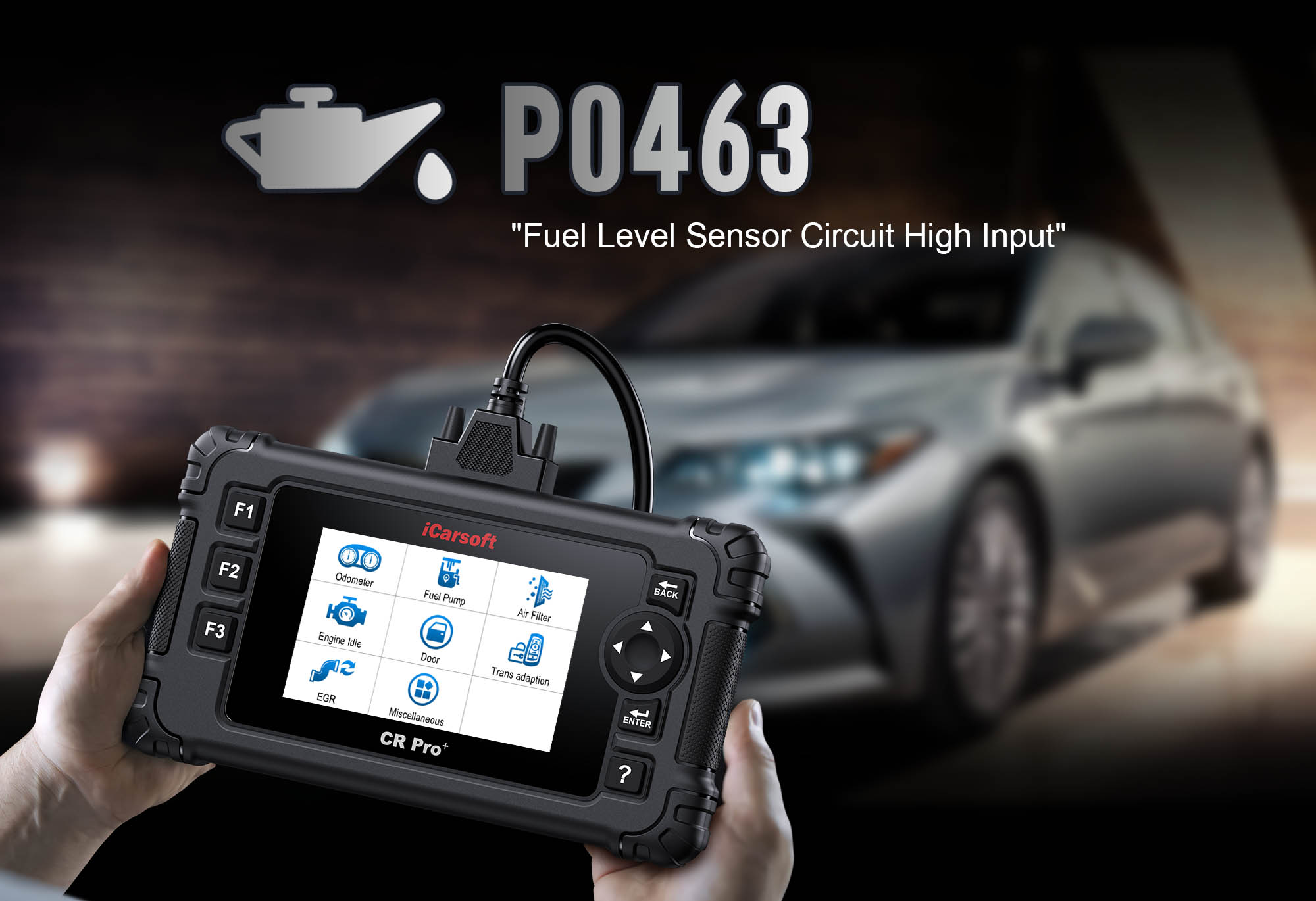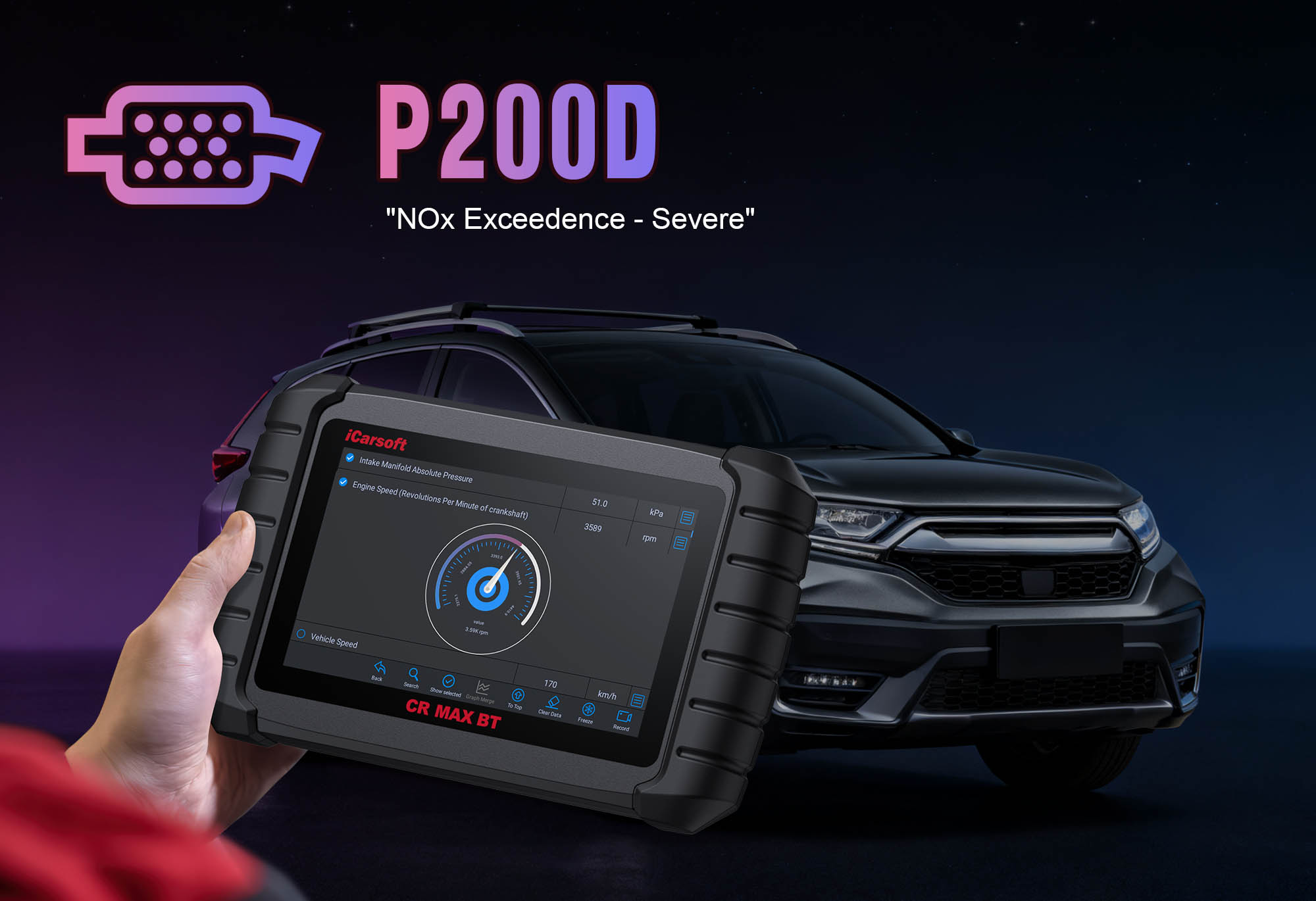Diagnose & Clear P0463 with iCarsoft CR Pro+: Fix Fuel Level Sensor Circuit High Input
If your check engine light illuminates and a scan returns P0463, your vehicle’s fuel level monitoring system is signaling a critical electrical issue. This generic OBD-II code stands for "Fuel Level Sensor Circuit High Input"—meaning the Engine Control Module (ECM) is receiving an abnormally high voltage signal from the fuel level sensor, preventing it from accurately calculating how much fuel is in the tank.
The fuel level sensor (usually part of the fuel pump assembly inside the tank) works by sending a variable voltage signal to the ECM: low voltage (e.g., 0.5V) when the tank is empty, and high voltage (e.g., 4.5V) when full. When P0463 occurs, the sensor sends a voltage that’s too high (often above the maximum threshold, like 5V) or stays stuck at a high level. This leads to inaccurate fuel gauge readings (e.g., gauge stuck on "Full" even when the tank is empty), unreliable range estimates, and in some cases, the ECM defaulting to a "limp mode" to avoid running out of fuel unexpectedly.
Basic scanners might only confirm "fuel level sensor fault" but can’t test sensor voltage or isolate circuit issues. The iCarsoft CR Pro+—with its real-time fuel level sensor data monitoring, circuit voltage testing, and component activation tools—solves this. Let’s walk through how to diagnose and resolve P0463.
 iCarsoft CR Pro+ monitoring fuel level sensor voltage to diagnose P0463
iCarsoft CR Pro+ monitoring fuel level sensor voltage to diagnose P0463
Understanding P0463: Causes & Key Symptoms
To tackle P0463 effectively, first recognize how high sensor input disrupts fuel level monitoring and your driving experience:
Key Symptoms of P0463
-
Check Engine Light: Illuminates when the ECM detects sensor voltage above the normal range (e.g., >5V) for 3+ consecutive drive cycles.
-
Inaccurate Fuel Gauge: The most noticeable symptom—gauge may stick on "Full," fluctuate randomly, or show a higher level than actual (e.g., shows half-full when the tank is empty).
-
Unreliable Range Estimate: The vehicle’s trip computer miscalculates remaining miles, leading to unexpected fuel shortages.
-
Hard Starting (In Severe Cases): If the ECM misinterprets fuel level as full when it’s empty, it may not adjust fuel injection properly, causing starting issues.
-
Dashboard Warnings: Some vehicles display "Fuel Level System Fault" or "Check Fuel Gauge" messages alongside the check engine light.
Common Causes of P0463
|
Cause
|
Description
|
|
Faulty Fuel Level Sensor
|
Internal wear (e.g., corroded float arm, damaged resistor) causes the sensor to send incorrect high voltage (accounts for ~50% of P0463 cases).
|
|
Short Circuit in the Sensor Circuit
|
Damaged wires or a short between the sensor and ECM create a high-voltage signal (e.g., wire touching the vehicle’s chassis, which carries 12V).
|
|
Loose or Corroded Electrical Connector
|
Poor contact at the sensor’s connector (on the fuel pump assembly) disrupts signal flow, leading to voltage spikes.
|
|
Damaged Fuel Pump Assembly
|
The sensor is integrated with the fuel pump—cracks or water intrusion in the assembly can damage the sensor circuit.
|
|
ECM Malfunction (Rare)
|
A faulty ECM may incorrectly interpret normal sensor voltage as "high," though this is usually paired with other electrical codes (e.g., P0606).
|
Why iCarsoft CR Pro+ Excels at Diagnosing P0463
The CR Pro+ outperforms basic tools with features tailored to fuel level sensor and circuit diagnostics—critical for pinpointing P0463’s root cause:
Real-Time Fuel Level Sensor Voltage Monitoring
Displays the sensor’s exact voltage (in 0.01V increments) to confirm if it exceeds the normal range (e.g., >5V = P0463 trigger)—no guesswork.
Circuit Continuity & Short Testing
Checks for short circuits or breaks in the sensor wiring, eliminating uncertainty about electrical issues (e.g., wire touching chassis).
Fuel Gauge Calibration Test
Compares the sensor’s voltage to the gauge’s displayed level, identifying mismatches (e.g., sensor shows 4.5V but gauge reads 3/4 full = sensor fault).
Vehicle-Specific Fuel System Diagrams
Preloaded with schematics of fuel pump assemblies, sensor locations, and wiring paths for 65+ makes (e.g., Honda Civic, Ford F-150, Toyota Tacoma).
Component Activation Tests
Verifies if the ECM can communicate with the sensor (sends "request fuel level" signal and checks for response)—rules out ECM communication issues.
Post-Repair Validation
Runs voltage and gauge tests after fixes to ensure the sensor and circuit work within manufacturer specs—confirms repairs are successful.
Step-by-Step: Diagnose P0463 with iCarsoft CR Pro+
-
1. Connect & Confirm the Code
Plug the CR Pro+ into your vehicle’s OBD-II port (under the dashboard) and power it on.
Select your vehicle via Auto VIN Scan (reads your VIN in 2 seconds) or manual entry (make/model/year/engine).
Navigate to Engine > Fault Codes > Read Codes to confirm P0463. Tap Code Details for vehicle-specific info (e.g., "Honda: Fuel Level Sensor Voltage = 5.2V – Exceeds Max Threshold").
-
2. Monitor Real-Time Fuel Level Sensor Voltage
First, verify the high voltage signal with the CR Pro+:
Ensure the fuel tank is at a known level (e.g., 1/2 full—use a gas station fill-up to confirm exact level).
Start the engine and let it idle for 2 minutes to stabilize the sensor.
Navigate to Engine > Live Data > Fuel System and select "Fuel Level Sensor Voltage" and "Fuel Level (Estimated %)."
Compare readings to manufacturer specs (found in CR Pro+’s "Vehicle Data" section):
- Normal: 0.5V (0% full) to 4.5V (100% full). For 1/2 full, voltage should be ~2.5V.
- P0463 Confirmation: Voltage >5V or stuck at a high level (e.g., 4.8V when tank is empty) = high input issue.
-
3. Check for Short Circuits in the Sensor Circuit
A short is a top cause of high voltage—diagnose with the CR Pro+:
Turn off the engine and disconnect the negative battery terminal (to avoid electrical damage during testing).
Locate the fuel level sensor connector using the CR Pro+’s Component Location > Fuel System > Fuel Level Sensor diagram. It’s typically on the fuel pump assembly (accessed via rear seat access panel or under the vehicle).
Disconnect the sensor connector (label wires with tape to avoid mixing up later).
Navigate to Special Functions > Electrical Tests > Circuit Short Test on the CR Pro+.
Connect the scanner’s test leads to the sensor’s signal wire (usually colored—check diagram, e.g., "Yellow with Black Stripe") and the vehicle’s chassis (ground).
Results:
- Short Detected: Scanner beeps or shows "Short to Ground/Voltage" = damaged wire touching chassis/12V source (repair or replace wiring).
- No Short: Proceed to test the sensor itself.
-
4. Test the Fuel Level Sensor for Faults
If no short is found, the sensor is likely faulty—test it with the CR Pro+:
Resistance Test:
Keep the sensor connector disconnected. Use the CR Pro+’s Ohmmeter Function to measure resistance between the sensor’s signal and ground pins.
Compare resistance to manufacturer specs (e.g., 100 ohms empty, 1,000 ohms full—varies by vehicle). A reading of 0 ohms (short) or infinite ohms (open) = faulty sensor.
Mechanical Inspection:
If the fuel pump assembly is accessible (e.g., via rear seat panel), carefully remove it (follow CR Pro+’s safety guidelines—relieve fuel pressure first with the scanner’s "Fuel Pressure Relief" function).
Inspect the sensor’s float arm for corrosion, bending, or breakage. Check the sensor’s resistor (the part the float slides on) for rust or physical damage.
A damaged float or resistor = replace the sensor (or entire fuel pump assembly if the sensor is integrated).
-
5. Inspect the Sensor Connector & Wiring
Poor connector contact can cause voltage spikes—check with the CR Pro+:
Connector Cleaning:
Use the CR Pro+’s Connector Inspection Guide to check for corrosion (white/green powder) or bent pins in the sensor connector.
Clean corroded terminals with electrical contact cleaner and a small brush. Straighten bent pins carefully with needle-nose pliers.
Wiring Inspection:
Follow the sensor’s wiring from the connector to the ECM (use the CR Pro+’s diagram). Look for:
- Frayed or cut wires (common near the fuel tank or undercarriage).
- Melted insulation (near the exhaust system, from heat).
- Loose connections at the ECM (rare, but inspect if other tests pass).
Repair damaged wiring with heat-shrink butt connectors to ensure a secure, waterproof seal.
-
6. Verify ECM Communication
Rule out a faulty ECM with the CR Pro+:
Reconnect the battery and sensor connector.
Navigate to Special Functions > ECM > Communication Test.
The scanner sends a test signal to the ECM, requesting fuel level data.
- "Communication Successful" = ECM is working correctly.
- "No Response" = ECM issue (consult a professional—ECM repairs require specialized tools).
-
7. Repair & Clear P0463
Fix the root cause based on diagnostics:
- Faulty Sensor: Replace the fuel level sensor (or fuel pump assembly if integrated—use OEM parts; check CR Pro+’s Part Lookup for the correct part number, e.g., Bosch 0280158040).
- Short Circuit: Repair or replace damaged wiring with fuel-resistant insulation.
- Corroded Connector: Clean or replace the connector (apply dielectric grease to new terminals to prevent future corrosion).
Clear the Code: Navigate to Engine > Fault Codes > Clear Codes to delete P0463 and any related electrical faults.
-
8. Validate the Repair
Confirm the sensor and circuit work correctly to avoid P0463 recurrence:
Refuel the tank to a known level (e.g., 1/2 full) at a gas station.
Start the engine and check live data—sensor voltage should match the known level (e.g., ~2.5V for 1/2 full), and the fuel gauge should display accurately.
Take a 15-minute test drive (include stop-and-go and highway driving) to ensure voltage and gauge readings stay consistent (no spikes or drops).
Re-scan with the CR Pro+: No P0463 recurrence + accurate gauge = successful repair.
Preventing P0463 Recurrence
The CR Pro+ helps maintain a reliable fuel level monitoring system long-term:
-
Sensor Maintenance: Use the CR Pro+’s Service Reminder to inspect the fuel level sensor every 30,000 miles (during fuel pump service, if applicable).
-
Connector Care: Check the sensor connector for corrosion every 15,000 miles—apply dielectric grease to terminals to prevent moisture damage.
-
Fuel Quality: Use Top Tier gasoline to reduce sediment buildup in the tank (sediment can scratch the sensor’s resistor and damage the float).
-
Avoid Overfilling: Stop refueling when the pump clicks off—overfilling can flood the sensor with fuel, causing corrosion of the float arm.
-
Winter Protection: In cold climates, use the CR Pro+ to check sensor voltage monthly—frozen fuel or ice can temporarily disrupt the sensor, but consistent high voltage = underlying issue (address immediately).
Conclusion
P0463’s high sensor input may seem like a minor inconvenience, but it risks leaving you stranded with an empty tank and failing emissions tests. The iCarsoft CR Pro+ turns this vague electrical fault into a solvable problem—with its voltage monitoring, circuit tests, and vehicle-specific guides, it eliminates the guesswork of chasing sensor or wiring issues that basic scanners miss.
Whether you’re replacing a faulty sensor, repairing a short circuit, or cleaning a corroded connector, the CR Pro+ ensures you fix the root cause. With this guide, you’ll turn a "fuel level sensor high input" fault into a confident repair—restoring accurate fuel gauge readings and peace of mind on every drive, knowing you’ll never be caught off guard by an empty tank again.
FAQs About P0463 Code
Q: Can I drive my vehicle with P0463?
A: Yes, but with caution. P0463 doesn’t affect engine performance directly, but inaccurate fuel gauge readings can lead to unexpected fuel shortages. Keep a log of miles driven after refueling (e.g., stop at 250 miles if your tank usually lasts 300) to avoid being stranded.
Q: How much does it cost to fix P0463?
A: Costs vary by cause: Fuel level sensor = $80–$250 (DIY, if accessible); fuel pump assembly (with integrated sensor) = $150–$400 (DIY); wiring repair = $10–$50 (DIY); professional labor = $100–$300 (if tank removal is needed). The CR Pro+ saves money by avoiding unnecessary part replacements.
Q: Why does P0463 come back after replacing the sensor?
A: Common reasons: 1) Unrepaired short circuit in wiring (sensor works but voltage is still high); 2) Corroded connector (not cleaned/replaced); 3) Wrong sensor (aftermarket sensor doesn’t match OEM specs). Re-run the CR Pro+’s circuit short test to find leftover issues.
Q: Do I need to relieve fuel pressure before replacing the fuel level sensor?
A: Yes—fuel pressure can cause fuel to spray when disconnecting the sensor. Use the CR Pro+’s "Fuel Pressure Relief" function (under Special Functions > Fuel System) to safely relieve pressure before removing the fuel pump assembly. Never skip this step—it prevents fire hazards.

 iCarsoft CR Pro+ monitoring fuel level sensor voltage to diagnose P0463
iCarsoft CR Pro+ monitoring fuel level sensor voltage to diagnose P0463



